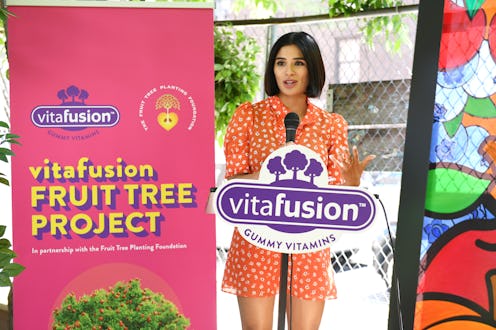Life
Diane Guerrero Tells Us How Growing Up In An Underserved Community Impacts Her Food Choices Today

You may know her from her role as Lina on Jane The Virgin, Maritza on Orange Is The New Black, or Crazy Jane on Doom Patrol, but actor and author Diane Guerrero has some pretty serious activist credit to her name. Guerrero has been an outspoken advocate for immigration reform after her family was deported to Colombia when she was 14, as she detailed in her memoir In The Country We Love: My Family Divided. Now, she’s raising awareness around nutrition access in underprivileged communities through a partnership with vitafusion gummy vitamins and the Fruit Tree Planting Foundation.
“The communities that suffer the most from environmental damage and lack of education around health are communities of color and low income communities,” Guerrero tells Bustle at a tree-planting event in Brooklyn, New York. “I also come from a community that was underserved. … I just remember going to school and not having fresh fruit, veggies in the cafeteria. And I remember seeing kids that were hungry.” Guerrero explains that she saw a lot of kids whose growth and development were affected by the lack of access to nutrition.
“A lot of mothers and fathers had to be at work. Maybe mothers and fathers didn't have enough money. Sometimes you had to buy what was cheaper and let's face it, fruits and vegetables are so expensive.”
The Fruit Tree Project, a collaboration between vitafusion and The Fruit Tree Planting Foundation that’s now in its third year, aims to plant 200,000 fruit trees by 2020. According to the Fruit Tree Project, planting this many trees will create 28 million pieces of fruit and 33 million pounds of oxygen, while getting rid of 40 million pounds of carbon dioxide from the air. What’s more, planting fruit trees in underserved communities will make it that much easier for families to access fresh fruit. Food deserts, or areas where residents can’t reliably get to full-service grocery stores, impact communities in diverse, hard to see ways, but researchers suggest that community gardens are a simple way to (literally) bring more fresh, nutrient-dense food to these areas.
“Even as small as planting a tree may seem, it's not a small endeavor,” Guerrero says. But, she explains, there's still more work to do.
“I think we need to tell more stories about our communities [and] raise awareness of the lack of resources that we have. And I think that us, as people who come from these communities and have been lucky enough to now enjoy healthy foods and healthy environments, [we] have to come back and be part of educating folks on how to change lifestyles.” Guerrero explains that over her life, she’s been privileged to learn how nutrient-dense foods can help with almost all aspects of health.
“I went to college with a girl who lived in the Berkshires, in Massachusetts," she says. "When she got sick, she knew how to take care of herself. She knew that when she was sick, she had to take zinc. She knew that she had to eat vegetables. She knew that she had to bundle herself up. You know, these are all things that I just didn't see growing up."
Now, she says, "I eat better. My body feels better. I sleep better. I have more energy to be more physical with my body. It helps me with all the traumas that I've experienced in my life, which a lot of us in our community experience.”
She explains that by getting families involved in this process can start much-needed conversations about nutrition. "Go home and talk to your families," she says. "Let's incorporate easy recipes to make better food choices."
While improving access to food is a difficult project, having these conversations in your communities is an easy start.